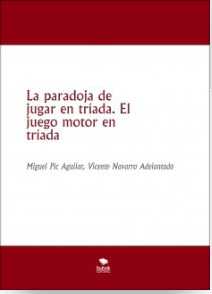| Ethnomotricity |
Motor actions Sector |
Variable |
Category |
Description |
|
Internal Logic
|
Rules |
IL- Rule |
Play |
1. Motor situation with rules |
| Game |
2. Motor situation without rules |
| Relationship with others |
IL- Interation |
Psychomotor |
3. Motor situation without motor interaction among players |
| Sociomotor |
4. Motor situation with motor interaction among playmates or opponents |
| IL- Domain |
Psychomotor |
5. Motor situation without motor interaction among players |
| Cooperation |
6. Motor situation with motor interaction among two or more playmates |
| Opposition |
7. Motor situation with motor interaction among two or more opponents |
| Cooperation- Opposition |
8. Motor situation with motor interaction among playmates and opponents |
| IL- Psychomotor-Structure |
Alone |
9. Psychomotor situation played by just one player |
| Alternate Comotricity |
10.Psychomotor situation where players act in different moments |
| Simultaneous Comotricity |
11.Psychomotor situation where players act in different zones |
| IL- Opposition-Structure |
Opposition- Alternate Intermotricity |
12.Motor situation where the opposition is done by contacting opponent objects |
| Individual Duel |
13.Motor situation of opposition between two players |
| All * All |
14.Motor situation of opposition among all the players |
| One * All |
15.Motor situation of opposition between a player against the other players |
| IL- Coop/Oppo Structure |
Coop-Oppo (CO) Alternate Intermotricity |
16.Motor situation where the C and O is done by contacting playmates or opponent objects |
| Team Duel |
17. Motor situation of C-O between two teams |
| Team*Others |
18. Motor situation of C-O with a team against the other players |
| Paradoxical |
19. Motor situation of C-O where players can become playmates or opponents at the same moment |
| IL- Communication Exclusiveness |
Exclusive Net |
20. Motor situation where players are exclusively playmates or opponents. |
| Ambivalent Net |
21. Motor situation where players can be playmates and opponents during the mach/game. |
| IL- Communication Stability |
Stable Net |
22. Motor situation where players maintain the same C or O ratio during the mach/game |
| Unstable Net |
23. Motor situation where players can change the C or O ratio during the mach/game |
| IL- Scoring interactions network |
Cooperation Goal Net |
24. Motor situation where success (point or role change) is achieved through cooperative actions |
| Antagonistic Scoring interaction network |
25. Motor situation where success (point or role change) is achieved through opposition actions |
| Mixed Scoring interactions network |
26. Motor situation where success (point or role change) is achieved through cooperative and opposition actions |
| No Scoring interactions network |
27. Motor situation without score interaction (psicomotor or cooperative) |
| IL- Opposition Type Interaction |
Oppo-Body contact |
28. Motor situation where opposition takes place through body contact |
| Oppo-Objects contact |
29. Motor situation where opposition takes place through objects |
| IL- Opposition Body Agressivity |
Oppo-By simple contact |
30. Motor situation where opposition takes place through a simple body contact. |
| Oppo Body contact-objects |
31. Motor situation where opposition takes place through the body contact with objects |
| Oppo-Strong hit to body |
32. Motor situation where opposition takes place through a strong impact on the body |
| Oppo Permanent body contact |
33. Motor situation where opposition takes place through permanent body contact |
| IL- Roles Changes Network |
Fixed Roles |
34. Motor situation where players do not change roles during the game |
| Local change Roles |
35. Motor situation where players changing roles do not change partner or adversary relationship |
| General change Roles |
36. Motor situation where players changing roles change partner or adversary relationship |
| Relationship with material |
IL- Object |
With objects |
37. Motor situation where motor actions take place through objects |
| No objects |
38. Motor situation where motor actions take place without objects. |
| Relationship with space |
IL- Space Stability |
Stable Space |
39. Motor situation in an environment without uncertainty or contingencies |
| Unstable Space |
40. Motor situation in an uncertain or unpredictable environment |
| IL- Space as Objective |
Fixed human space |
41. Motor situation where players are looking for a fixed human space |
| Mobile human space |
42.Motor situation in which the players look for a human space with movement |
| Fixed artificial space |
43.Motor situation where players are looking for a fixed artificial space |
| Mobile artificial space |
44.Motor situation where players are looking for an artificial space with movement |
| IL- Coop-Opposition Charge Distance |
Almost null Charge distance |
45.Motor situation in the interaction is done with almost no distance (minus 1 meter) |
| Reduced contact charge distance |
46.Motor situation in the interaction is done with a distance of 1 to 3 meters |
| Median contact charge distance |
47.Motor situation in the interaction is done with a distance of 3 to 5 meters |
| Long charge distance |
48.Motor situation in the interaction is done with a distance of >5 meters |
| IL- Oppos Guard Distance |
Almost null Guard Distance |
49.Motor situation where at the beginning the players are separated to an almost null distance (less than 1 meter) |
| Reduced Guard Distance |
50.Motor situation where at the beginning the players are separated at a distance of 1 to 3 meters |
| Median Guard Distance |
51.Motor situation where at the beginning the players are separated at a distance of 3 to 5 meters |
| Long Guard Distance |
52.Motor situation where at the beginning the players are separated at a distance of 5 meters |
| Relationship with time |
IL- Score |
Finished Task |
53.Motor situation which ends after performing a task (jump, run, throw…) |
| Score Limit |
54.Motor situation which ends after reaching a number of points |
| Time limit |
55.Motor situation which ends after a time limit |
| Score-Time limit |
56.Motor situation which ends after reaching a number of points or after a set time has elapsed |
| Without Score |
57.Motor situation without end |
| External Logic
|
Type of Game |
EL-Military Game |
Military Game |
58.Motor situation with military connotations |
| Non Military Game |
59.Motor situation without military connotations |
| Protagonists |
EL- Age |
Children |
60. Motor situation practiced by children |
| Youth |
61.Motor situation practiced by young people |
| Adults |
62.Motor situation practiced by adults |
| Children-Youth |
63.Motor situation practiced by children & young people |
| All ages |
64.Motor situation practiced by people of different ages |
| EL- Gender |
Only male |
65.Motor situation practiced by the male gender |
| Only female |
66.Motor situation practiced by the female gender |
| Separated Male or Female |
67.Motor situation practiced by the male or female gender separately |
| Mixed Male-Female |
68.Motor situation practiced by the masculine and feminine gender together |
| Material |
EL- Material Provenance |
Artificial material |
69.Motor situation practiced with objects obtained from an artificial environment |
| Natural material |
70.Motor situation practiced with objects obtained from a natural environment |
| Natural – artificial material |
71.Motor situation practiced with objects obtained from an artificial or natural environment |
| Bought material |
72.Motor situation practiced with bought objects |
| Without material |
73.Motor situation practiced without objects |
| EL- Material Modification |
Modified non-military material |
74.Motor situation practiced with modified non-military objects |
| Unmodified non-military material |
75.Motor situation practiced with non-modified non-military objects |
| Unmodified Military material |
76.Motor situation practiced with non-modified military objects |
| Without Material |
77.Motor situation practiced without objets |
| EL- Material Elaboration |
Handmade Material |
78.Motor situation practiced with objects made by the players |
| External made Material |
79.Motor situation with objects made by other people |
| Without Material elaboration |
80.Motor situation practiced without objets |
| Zones |
EL- Zones Location |
Inside – Zones |
81.Motor situation practiced in an indoor space |
| Outside – Zones |
82.Motor situation practiced in an outdoor space |
| In-Out – Zones |
83.Motor situation practiced in an indoor or outdoor space |
| EL- Zones Preparation |
Prepared – Zone |
84.Motor situation practiced in a space prepared specifically for the game |
| Poorly prepared – Zone |
85.Motor situation practiced in an barely prepared space for the game |
| Not Prepared – Zone |
86.Motor situation practiced in an unconditioned space. |
| Temporal Location |
EL- Calendar |
With calendar |
87.Motor situation practiced according to a schedule |
| Without calendar |
88.Motor situation practice at any time of the year |






